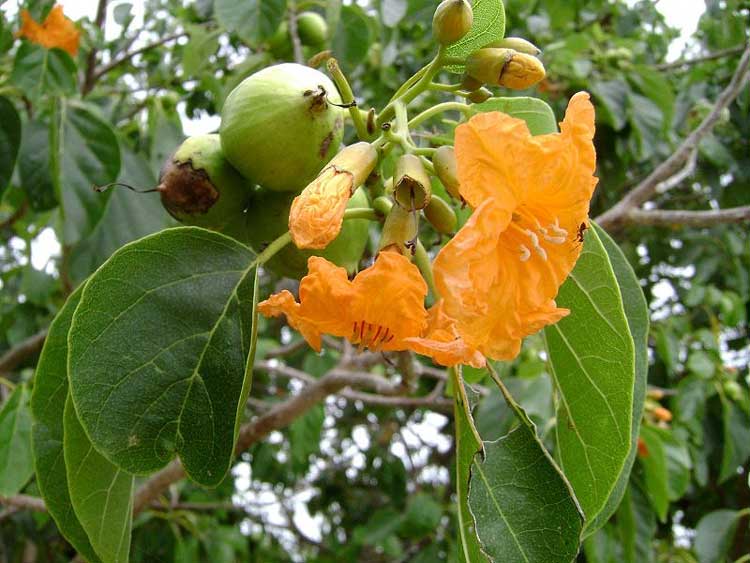Cordia subcordata (Photo: *) Cladus: Eukaryota Name Cordia subcordata Lam. References * Tableau Encyclopedique et Methodique ... Botanique 1:421. 1792
--- Cordia subcordata is a species of flowering tree in the borage family, Boraginaceae, that is native to eastern Africa, South Asia, Southeast Asia, northern Australia and the Pacific Islands.[2] The plant is known by a variety of names including Mareer, Manjak, Snottygobbles, Glueberry, Narrow-leafed Bird Lime Tree, "Kanawa," Tou, and Kou.
C. subcordata grows to 7–10 m (23–33 ft) at maturity, but may be as tall as 15 m (49 ft). It has ovate leaves that are 8–20 cm (3.1–7.9 in) and 5–13 cm (2.0–5.1 in) wide.[3] Flowers The tubular flowers of C. subcordata are 2.5–4 cm (0.98–1.6 in) in diameter and form cymes or panicles.[3] Petals are orange and the sepals are pale green. Blooming occurs throughout the year, but most flowers are produced in the spring.[4] Fruit C. subcordata produces fruit year round. They are spherical, 2–3 cm (0.79–1.2 in) long, and woody when mature. Each fruit contains four or fewer seeds that are 10–13 mm (0.39–0.51 in) long. The fruit are buoyant and may be carried long distances by ocean currents.[3] Habitat C. subcordata is a tree of the coasts, found at elevations from sea level to 30 m (98 ft), but may grow at up to 150 m (490 ft). It grows in areas that receive 1,000–4,000 mm (39–160 in) of annual rainfall. C. subcordata prefers neutral to alkaline soils (pH of 6.1 to 7.4), such as those originating from basalt, limestone, clay, or sand. Allowable soil textures include sand, sandy loam, loam, sandy clay loam, sandy clay, clay loam, and clay.[3] Uses The seeds are edible and have been eaten during famine. C. subcordata burns readily, and this lead to the nickname of Kerosene Tree in Papua New Guinea.[3] The wood of the tree has a specific gravity of 0.45, is soft, durable, easily worked,[4] and resistant to termites. In ancient Hawaiʻi kou wood was used to make ʻumeke (bowls), utensils, and ʻumeke lāʻau (large calabashes) because it did not impart a foul taste to food. ʻUmeke lāʻau were 8–16 litres (2–4 gal) and used to store and ferment poi. The flowers were used to make lei, while a dye for kapa cloth and aho (fishing lines) was derived from the leaves.[3] References 1. ^ World Conservation Monitoring Centre (1998). Cordia subcordata. In: IUCN 1998. IUCN Red List of Threatened Species. Downloaded on 02 March 2010. Source: Wikipedia, Wikispecies: All text is available under the terms of the GNU Free Documentation License |
|

